|
|
|
Sort Order |
|
|
|
Items / Page
|
|
|
|
|
|
|
| Srl | Item |
| 1 |
ID:
176111
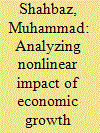

|
|
|
|
|
| Summary/Abstract |
Several Asian countries are facing challenges regarding the accomplishment of the objectives of Sustainable Development Goals (SDGs), and India is facing a similar situation. Following this, this study talks about designing an SDG framework for India, which can be used as a benchmark for other Asian countries. In this pursuit, this study looks into whether per capita income, energy use, trade openness, and oil price have any impact on CO2 emissions between 1980 and 2019. The nonlinear autoregressive distributed lag approach proves that the fluctuations in independent variables have an asymmetric long-term impact on CO2 emissions. The results reveal that the prevailing economic growth pattern in India is environmentally unsustainable, because of its dependence on fossil fuel-based energy consumption and imported crude oil. Import substitution has been identified as one of the first stepping stones to address this issue, and accordingly, a multipronged SDG framework has been designed based on the direct and extended version of the study outcomes. While the Central policy framework shows a way to address SDG 7, SDG 8, SDG 12, and SDG 13, the Tangential policy framework shows the way to sustain the Central policy framework by addressing SDG 4.
|
|
|
|
|
|
|
|
|
|
|
|
|
|
|
|
| 2 |
ID:
132768
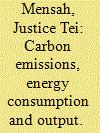

|
|
|
|
|
| Publication |
2014.
|
| Summary/Abstract |
Following the recent global economic downturn, attention has gradually shifted towards emerging economies which have experienced robust growth amidst sluggish growth of the world economy. A significant number of these emerging economies are in Africa. Rising growth in these economies is associated with surging demand for energy to propel the engines of growth, with direct implications on emissions into the atmosphere. Further, these economies are constantly being shaped by series of structural reforms with direct and indirect effects on growth, demand for energy, etc. To this end, this paper examines the causal dynamics among energy use, real GDP and CO2 emissions in the presence of regime shifts in six emerging African economies using the Gregory and Hansen (1996a). J. Econ. 70, 99-126 threshold cointegration and the Toda and Yamamoto (1995). J. Econometrics. 66, 225-250 Granger causality techniques. Results confirm the presence of regime shift effects in the long run inter-linkages among energy use, real GDP and CO2 emissions in the countries considered, thus indicating that structural changes have both economic and environmental effects. Hence, integration of energy and environmental policies into development plans is imperative towards attaining sustainable growth and development.
|
|
|
|
|
|
|
|
|
|
|
|
|
|
|
|
| 3 |
ID:
117220
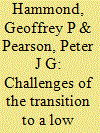

|
|
|
|
|
| Publication |
2013.
|
| Summary/Abstract |
Electricity generation presently contributes approximately 30% of United Kingdom (UK) carbon dioxide (CO2) emissions (Alderson et al., 2012 and Parliamentary, 2007), the principal 'greenhouse gas' (GHG) having an atmospheric residence time of about 100 years (Hammond, 2000). This share mainly arises from the use of fossil fuel (coal and natural gas) combustion for this purpose. Changes in atmospheric concentrations of GHGs affect the energy balance of the global climate system. Human activities have led to quite dramatic increases since 1950 in the 'basket' of GHGs incorporated in the Kyoto Protocol; concentrations have risen from 330 ppm to about 430 ppm currently (IPCC, 2007). Prior to the first industrial revolution in the 18th Century the atmospheric concentration of 'Kyoto gases' was only some 270 ppm. The cause of the observed rise in global average near-surface temperatures over the second half of the 20th Century has been a matter of dispute and controversy. But the most recent (2007) scientific assessment by the Intergovernmental Panel on Climate Change (IPCC) states with 'very high confidence' that humans are having a significant impact on the global warming (IPCC, 2007). They argue that GHG emissions from human activities trap long-wave thermal radiation from the Earth's surface in the atmosphere (not strictly 'greenhouse' phenomena), and that these are the main cause of rises in climatic temperatures. In order to mitigate anthropogenic climate change, the Royal Commission on Environmental Pollution in the UK (RCEP, 2000) recommended at the turn of the Millennium a 60% cut in UK CO2 emissions by 2050. The British Government subsequently set a tougher, legally binding target of reducing the nation's CO2 emissions overall by 80% by 2050 in comparison to a 1990 baseline ( Department of Trade and Industry [DTI], 2007 and Climate, 2008).
|
|
|
|
|
|
|
|
|
|
|
|
|
|
|
|
| 4 |
ID:
141246
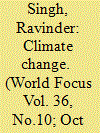

|
|
|
|
|
| Summary/Abstract |
Climate Change is a serious global environmental concern. It is primarily caused by the building up of Green House Gases (GHG) in the atmosphere. The global increases in carbon dioxide concentration (CO2) are primarily due to fossil fuel use and due to agriculture land use change yielding the methane and nitrous oxide. Global Warming is a specific example of the broader term “Climate Change”. It refers to the observed increase in the average temperature of the air near earth’s surface and oceans in recent decades. It is adversely affecting particularly the developing countries because they have neither the capacity nor the resources to deal with this challenge threatening the human existence (1). Scientific studies have proved the global atmospheric concentrations of most important Green House Gases-carbon dioxide (CO2), methane (CH4) and nitrous oxide (NO2) have increased markedly due to human activities since 1750.
|
|
|
|
|
|
|
|
|
|
|
|
|
|
|
|
| 5 |
ID:
105501
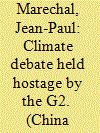

|
|
|
| 6 |
ID:
141238
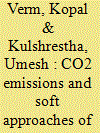

|
|
|
|
|
| Summary/Abstract |
During the last five years, India has achieved to become world’s ninth largest economy with a real GDP growth of 8.7% which is exceptional evidence of the growth of Indian economy [Energy Statistics, 2013]. Such a high economic growth involves enormous pressure on the energy resources of the country resulting in increased demand and supply imbalance across all energy sources. India’s energy basket has mixture of all the resources with the dominance of coal [Energy Statistics, 2013]. Being the capital of India, Delhi is the hub of opportunities for all including youth, entrepreneurs, governments, and the directly or indirectly associated people. This catalyses the processes of migration which is responsible for the growth of population, size of the urban area and industrialization [Aggarwal and Jain, 2014]. This further leads towards increased energy consumption posing serious environmental and human health threats. The worsening air quality of the city is triggering various respiratory problems such as chronic bronchitis, lung cancer and infections etc. Adverse air quality also affects visibility and climate, most of the time making irreversible changes. One such example is climate change which is difficult to cope by `hard’ mitigating methods due to human desires and geographical competitiveness for modern development. Due to these reasons many people believe that our climatic conditions will never be restored into the original form and adaptation is the only option for future generation. However, it is possible to reduce greenhouse gases (GHG) and carbon emissions by `soft’ techniques. Taking into account the consumption of fossil fuels by different sources and their emissions in Delhi National Capital Region (NCR), this article focuses upon the soft approaches to mitigate (GHG) and carbon emissions.
|
|
|
|
|
|
|
|
|
|
|
|
|
|
|
|
| 7 |
ID:
177152
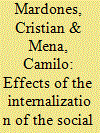

|
|
|
|
|
| Summary/Abstract |
In 2017, environmental taxes on global pollutants (CO2) and local air pollutants (SO2, NOX, and PM) began to be collected to reduce emissions in Chile. However, large emitting sources only are subject to environmental taxes and the tax rates are much lower than the social cost of these pollutants, which does not allow to fully internalize the generated damages. For the above, this study uses the environmental extension of the Leontief price model and microsimulations to estimate the economic, environmental, distributive, and poverty short-term effects associated with the application of Pigouvian taxes on all emissions generated by productive activities. The results show that currently there are too many resources allocated to activities that generate strong negative externalities, mainly in the electricity and transport sectors. Specifically, the emissions are reduced almost 10 times more than in the current tax scenario if environmental taxes equal to social costs are applied, but relevant negative indirect effects are generated that make the practical application of a tax of these characteristics unrealistic. For example, there is a fall between 1.2% and 2.9% in employment, slightly worsening the income distribution and increases the poverty rate between 0.9 and 2.3 percentage points.
|
|
|
|
|
|
|
|
|
|
|
|
|
|
|
|
| 8 |
ID:
094855
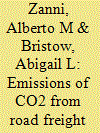

|
|
|
|
|
| Publication |
2010.
|
| Summary/Abstract |
Freight transport has been receiving increasing attention in both literature and practice following the growing recognition of its importance in urban transport planning. This paper analyses historical and projected road freight CO2 emissions in the city of London and explores the potential mitigation effect of a set of freight transport policies and logistics solutions. Findings indicate a range of policies with potential to reduce emissions in the period up to 2050. However, this reduction would appear to only be capable of partly counterbalancing the projected increase in freight traffic. More profound behavioural measures therefore appear to be necessary for London's CO2 emissions reduction targets to be met.
|
|
|
|
|
|
|
|
|
|
|
|
|
|
|
|
| 9 |
ID:
097246


|
|
|
|
|
| Publication |
2010.
|
| Summary/Abstract |
This paper attempts to estimate the environmental Kuznets curve (EKC) in the case of France by taking the role of nuclear energy in electricity production into account. We adopt the autoregressive distributed lag (ARDL) approach to cointegration as the estimation method. Additionally, we examine the stability of the estimated models and investigate the Granger causality relationships between the variables in the system. The results from our estimation provide evidence supporting the EKC hypothesis, and the estimated models are shown to be stable over the sample period. The uni-direction running from other variables to CO2 emissions are confirmed from the casualty tests. Specifically, the uni-directional causality relationship running from nuclear energy to CO2 emissions statistically provides evidence on the important role of nuclear energy in reducing CO2 emissions.
|
|
|
|
|
|
|
|
|
|
|
|
|
|
|
|
| 10 |
ID:
125867
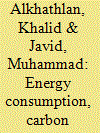

|
|
|
|
|
| Publication |
2013.
|
| Summary/Abstract |
The objective of this study is to examine the relationship among economic growth, carbon emissions and energy consumption at the aggregate and disaggregate levels. For the aggregate energy consumption model, we use total energy consumption per capita and CO2 emissions per capita based on the total energy consumption. For the disaggregate analysis, we used oil, gas and electricity consumption models along with their respective CO2 emissions. The long-term income elasticities of carbon emissions in three of the four models are positive and higher than their estimated short-term income elasticities. These results suggest that carbon emissions increase with the increase in per capita income which supports the belief that there is a monotonically increasing relationship between per capita carbon emissions and per capita income for the aggregate model and for the oil and electricity consumption models. The long- and short-term income elasticities of carbon emissions are negative for the gas consumption model. This result indicates that if the Saudi Arabian economy switched from oil to gas consumption, then an increase in per capita income would reduce carbon emissions. The results also suggest that electricity is less polluting than other sources of energy.
|
|
|
|
|
|
|
|
|
|
|
|
|
|
|
|
| 11 |
ID:
098651
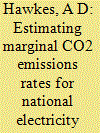

|
|
|
|
|
| Publication |
2010.
|
| Summary/Abstract |
The carbon dioxide (CO2) emissions reduction afforded by a demand-side intervention in the electricity system is typically assessed by means of an assumed grid emissions rate, which measures the CO2 intensity of electricity not used as a result of the intervention. This emissions rate is called the "marginal emissions factor" (MEF). Accurate estimation of MEFs is crucial for performance assessment because their application leads to decisions regarding the relative merits of CO2 reduction strategies. This article contributes to formulating the principles by which MEFs are estimated, highlighting the strengths and weaknesses in existing approaches, and presenting an alternative based on the observed behaviour of power stations. The case of Great Britain is considered, demonstrating an MEF of 0.69 kgCO2/kW h for 2002-2009, with error bars at +/-10%. This value could reduce to 0.6 kgCO2/kW h over the next decade under planned changes to the underlying generation mix, and could further reduce to approximately 0.51 kgCO2/kW h before 2025 if all power stations commissioned pre-1970 are replaced by their modern counterparts. Given that these rates are higher than commonly applied system-average or assumed "long term marginal" emissions rates, it is concluded that maintenance of an improved understanding of MEFs is valuable to better inform policy decisions.
|
|
|
|
|
|
|
|
|
|
|
|
|
|
|
|
| 12 |
ID:
098590


|
|
|
|
|
| Publication |
2010.
|
| Summary/Abstract |
CO2 emissions in the atmosphere are increasing continually, which are mainly originated from burning of fossil fuels. The fossil fuels are expected to remain a major component of the world's energy supply in the near future, because of their inherent advantages. Therefore, various measures have to be considered to reduce anthropogenic CO2 emissions. Increasing the efficiency of energy usage and/or developing lower carbon or non-carbon energies to replace high carbon fuels may bring the result of the reduction of the accumulation of CO2 in the atmosphere. The other alternative to reduce CO2 concentrations in atmosphere include gaseous storage in various deep geological formations, liquid storage in the ocean, and solid storage by reaction of CO2 with metal oxides to produce stable carbonates. In this article, the geological storage options of CO2 are examined. They are discussed in terms of applicability, cost, storage capacity and safety.
|
|
|
|
|
|
|
|
|
|
|
|
|
|
|
|
| 13 |
ID:
105762


|
|
|
|
|
| Publication |
2011.
|
| Summary/Abstract |
Along the lines of the Kaya identity, we perform a decomposition analysis of historical and projected emissions data for China. We compare the results with reduction requirements implied by globally cost-effective mitigation scenarios and official Chinese policy targets. For the years 1971-2000 we find that the impact of high economic growth on emissions was partially compensated by a steady fall in energy intensity. However, the end - and even reversal - of this downward trend, along with a rising carbon intensity of energy, resulted in rapid emission growth during 2000-2007. By applying an innovative enhanced Kaya-decomposition method, we also show how the persistent increase in the use of coal has caused carbon intensity to rise throughout the entire time-horizon of the analysis. These insights are then compared to model scenarios for future energy system developments generated by the ReMIND-R model. The analysis reaffirms China's indispensable role in global efforts to implement any of three exemplary stabilization targets (400, 450, or 500 ppm CO2-only), and underscore the increasing importance of carbon intensity for the more ambitious targets. Finally, we compare China's official targets for energy intensity and carbon intensity of GDP to projections for global cost-effective stabilization scenarios, finding them to be roughly compatible in the short-to-mid-term.
|
|
|
|
|
|
|
|
|
|
|
|
|
|
|
|
| 14 |
ID:
097531
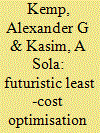

|
|
|
|
|
| Publication |
2010.
|
| Summary/Abstract |
The owners of 8 power plants in the UK have announced interest in capturing and sequestering CO2. Using various criteria from the literature twenty fields in the UK Continental Shelf were selected as possible sinks for the captured CO2. Using a linear programming model, the study determined the least-cost transportation network under various constraints on the volumes of CO2 captured from the sources and the injection rates at the sinks. Four scenarios were developed to gauge the sensitivity of the results to these and to the availability of fields for EOR and Permanent Storage. Depending on the scenario, the optimal transportation CAPEX was found to range between £3.5 and £5.2 billion in real terms. With higher minimum injection rates at the fields, accelerating CO2-EOR investments was found to reduce unit transportation CAPEX compared to waiting for their cessation of production dates. On the other hand a combination of the later availability of the CO2-EOR fields plus a lower minimum injection rate yielded the minimum transportation network CAPEX. The modelling also unveiled the problem of CO2 supply overflows in the longer term. The modelling approach has wide applicability beyond the UK.
|
|
|
|
|
|
|
|
|
|
|
|
|
|
|
|
| 15 |
ID:
150779


|
|
|
|
|
| Summary/Abstract |
In spite of the extensive literature on greenhouse gas emission inequalities at the world-wide level, most of the evidence so far has been based on country-level data. However, the within-country dimension matters for both the implementation and the policy formation of climate policies. As a preliminary step towards a better understanding of within-country inequalities, this paper measures their extent for the two major greenhouse gases, CO2 and CH4, over the 1970–2008 period. Using Theil-index decompositions, we show that within-country inequalities account for the bulk of global inequality, and tend to increase over the sample period, in contrast with diminishing between-country inequalities. Including differences across sectors reveals that between-sector inequalities matter more than between-country inequalities, and between-sector inequalities become the dominant source of global inequality at the end of the sample period in the CO2 case. Finally, estimated social tensions arising from the disconnection between emissions and future damages turn out to be increasing as soon as within-country disparities are taken into account. These orders of magnitude should be kept in mind while discussing the efficiency and fairness of alternative paths in combating global warming.
|
|
|
|
|
|
|
|
|
|
|
|
|
|
|
|
| 16 |
ID:
103334


|
|
|
|
|
| Publication |
2011.
|
| Summary/Abstract |
A greenhouse gas emission trading system is considered an important policy measure for the deployment of CCS at large scale. However, more insights are needed whether such a trading system leads to a sufficient high CO2 price and stable investment environment for CCS deployment. To gain more insights, we combined WorldScan, an applied general equilibrium model for global policy analysis, and MARKAL-NL-UU, a techno-economic energy bottom-up model of the Dutch power generation sector and CO2 intensive industry. WorldScan results show that in 2020, CO2 prices may vary between 20 €/tCO2 in a Grand Coalition scenario, in which all countries accept greenhouse gas targets from 2020, to 47 €/tCO2 in an Impasse scenario, in which EU-27 continues its one-sided emission trading system without the possibility to use the Clean Development Mechanism. MARKAL-NL-UU model results show that an emission trading system in combination with uncertainty does not advance the application of CCS in an early stage, the rates at which different CO2 abatement technologies (including CCS) develop are less crucial for introduction of CCS than the CO2 price development, and the combination of biomass (co-)firing and CCS seems an important option to realise deep CO2 emission reductions.
|
|
|
|
|
|
|
|
|
|
|
|
|
|
|
|
| 17 |
ID:
094529
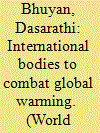

|
|
|
|
|
| Publication |
2010.
|
| Summary/Abstract |
Global warming, as a suspected aspect of ongoing climate change, is now a matter of paramount concern but governments have found it very difficult so far to agree on the ways and means to limit it and even on the diagnosis of the situation because of the fears that measures to reduce "greenhouse" gas emissions will have negative effects on the economy. Major developing nations reject mandatory limits on their emissions which they regard as attempts by the richer states to hobble their progress. Dasarathi Bhuyan argues that the very philosophy of limitless economic growth is deeply flawed as it does not take into account the finite amount of natural resources and the relative fragility of our planetary ecosystem, which most religions warn us about.
|
|
|
|
|
|
|
|
|
|
|
|
|
|
|
|
| 18 |
ID:
094212
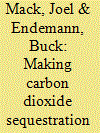

|
|
|
|
|
| Publication |
2010.
|
| Summary/Abstract |
As the United States moves closer to a national climate change policy, it will have to focus on a variety of factors affecting the manner in which the country moves toward a future with a substantially lower carbon footprint. In addition to encouraging renewable energy, smart grid, clean fuels and other technologies, the United States will need to make substantial infrastructure investments in a variety of industries. Among the significant contributors to the current carbon footprint in the United States is the use of coal as a major fuel for the generation of electricity. One of the most important technologies that the United States can employ to reduce its carbon footprint is to sequester the carbon dioxide ("CO2") from coal-fired power plants. This article focuses on the legal and policy issues surrounding a critical piece of the necessary sequestration infrastructure: CO2 pipelines that will carry CO2 from where it is removed from fuel or waste gas streams to where it will be sequestered. Ultimately, this article recommends developing a federally regulated CO2 pipeline program to foster the implementation of carbon sequestration technology.
|
|
|
|
|
|
|
|
|
|
|
|
|
|
|
|
| 19 |
ID:
137815
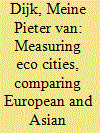

|
|
|
|
|
| Summary/Abstract |
Many cities have taken initiatives to achieve more sustainable development or to become ecological cities. In this paper, ten dimensions are suggested for defining ecological cities and an effort has been made to provide indicators to measure them. Many cities claim to be ecological cities, but there are no non-ambiguous definitions of ecological cities and few efforts have been made to measure to what extent the cities have achieved their goal. This paper considers the efforts of Beijing and Rotterdam to become more eco cities, using these dimensions. What can we learn from these experiences for developing the city of the future? In an illustrative effort to apply the suggested criteria, Rotterdam scored slightly better than Beijing. The latter city is facing more serious environmental problems and is willing to try more innovative solutions, while Rotterdam spends more money on prevention and CO2 reduction.
|
|
|
|
|
|
|
|
|
|
|
|
|
|
|
|
| 20 |
ID:
094279
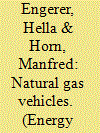

|
|
|
|
|
| Publication |
2010.
|
| Summary/Abstract |
In Europe natural gas vehicles play a minor role. A decisive reason for this is the dependence of most European countries from gas imports. Except for Italy, there is no tradition to use natural gas as fuel. In addition, there is a lack of infrastructure (e.g. fuelling stations). In contrast to Europe, in Latin American and Asian countries natural gas vehicles are widespread. Some countries foster natural gas vehicles because they have own gas resources. Many countries must reduce the high air pollution in big cities. Environmental reasons are the main motive for the use of natural gas vehicles in Europe. In last years, high oil prices stimulated the use of natural gas as fuel. European governments have developed incentives (e.g. tax reductions) to foster natural gas vehicles. However, the focus is on hybrid technology and the electric car, which, however, need further technical improvement. In contrast, the use of natural gas in conventional engines is technically mature. Additional gas imports can be avoided by further improvements of energy efficiency and the use of renewable energy. In sum, the market penetration of natural gas as fuel should be promoted in Europe.
|
|
|
|
|
|
|
|
|
|
|
|
|
|
|
|
|
|
|
|
|